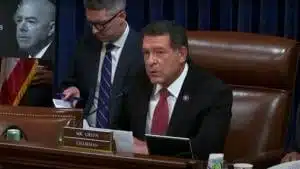(The Center Square) – A federal district judge in Massachusetts, Judge Brian Murphy, sought to prevent deportation of violent criminals but was overruled by the U.S. Supreme Court.
On July 4, eight convicted felons, citizens of Burma, Cuba, Laos, Mexico, Vietnam and South Sudan, were deported to South Sudan. The country’s leaders have entered into an agreement with the U.S. to detain criminal foreign nationals, including those who aren’t their citizens. El Salvador and others have entered into similar agreements, with the U.S. government agreeing to pay for detention costs.
U.S. deportation efforts rely on diplomacy with foreign governments, many of which won’t accept their own citizens. Under previous administrations, federal efforts to deport criminal illegal foreign nationals failed because many countries wouldn’t take back their citizens. As a result, they illegally remained in the U.S. even though they had deportation orders from a federal immigration judge, authorities have explained to The Center Square. Under the Trump administration, this has changed.
Those deported to South Sudan were all men illegally in the U.S. with extensive criminal histories, including felony convictions and prison sentences in the U.S. They all received due process in federal immigration court and received final removal orders from federal immigration judges that were never enforced, including one dating back to 1999.
Burmese national Kyaw Mya was convicted of lascivious acts with a child-victim under age 12 and sentenced to 10 years in prison and paroled after four years. ICE- St. Paul officers arrested him; his final removal order was issued March 17, 2022.
Burmese national Nyo Myint was convicted of first-degree sexual assault involving a victim mentally and physically incapable of resisting and sentenced to 12 years in prison. He was also charged with aggravated assault-nonfamily strongarm and a registered sex offender. ICE- St. Paul officers arrested him; his final removal order was issued August 17, 2023.
Cuban national Enrique Arias-Hierro was convicted of homicide, armed robbery, false impersonation of official, kidnapping, and robbery strong arm. His final removal order was issued September 13, 1999. Due to Cuban authorities refusing to take him, he remained illegally in the U.S.
Cuban national Jose Manuel Rodriguez-Quinones was convicted of attempted first-degree murder with a weapon, battery and larceny, and cocaine possession and trafficking. ICE Miami officers arrested him in April; his final removal order was issued Dec. 4, 2012.
Laos national Thongxay Nilakout was convicted of first-degree murder and robbery and sentenced to life in prison. ICE Los Angeles officers arrested him in January. His final removal order was issued July 12, 2023.
Mexican national Jesus Munoz-Gutierrez was convicted of second-degree murder and sentenced to life in prison. ICE Miami officers arrested him in May. His final removal order was issued June 16, 2005.
Vietnamese national Tuan Thanh Phan was convicted of first-degree murder and second-degree assault and sentenced to 22 years in prison. ICE Seattle officers arrested him in May. His final removal order was issued June 17, 2009.
The only South Sudan national in the deportation group was Dian Peter Domach, who was first encountered by ICE in 2011 and received a final removal order on July 19, 2011. He wasn’t deported and remained in the U.S. illegally and committed a range of crimes. He was convicted of robbery and possession of a firearm, possession of defaced firearm, possession of burglar’s tools, and driving under the influence.
Murphy, born in 1979, a former public defender and a criminal defense attorney, was appointed by former President Joe Biden less than six months ago. Murphy argued a Supreme Court ruling didn’t apply to his injunction, seeking to keep convicted felons, including sex offenders and murderers, in the U.S. in violation of federal law. His order violated due process, critics argue, because the convicted felon illegal foreign nationals already appeared multiple times before federal immigration judges who issued judgements against them and final orders of removal.
Justice Elena Kagan chastised Murphy in the court’s July 3 ruling, affirming the Trump administration’s authority to deport illegal foreign nationals to third-party countries.
The article predominantly presents facts about the deportation of convicted foreign criminals and the associated legal proceedings, but it is framed in a manner that aligns with a law-and-order, tough-on-crime perspective commonly associated with right-leaning viewpoints. The language emphasizes the criminality of the individuals, the failure of previous administrations (implicitly the Biden administration) to enforce deportations effectively, and the positive framing of the Trump administration’s policies as a corrective measure. The piece also characterizes Judge Murphy’s injunction as an obstruction of justice and highlights criticism of his ruling, which reflects a particular ideological stance favoring stricter immigration enforcement and portrays judicial resistance as misguided. While it reports on judicial and executive actions, the tone and selective details contribute to a bias that leans toward supporting hardline immigration enforcement policies typical of conservative perspectives, rather than maintaining strictly neutral or centrist reporting.




















































